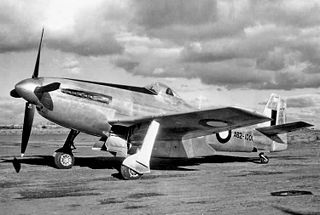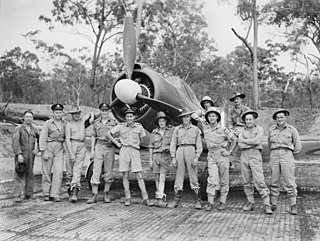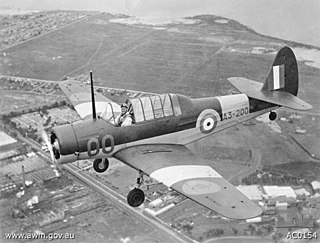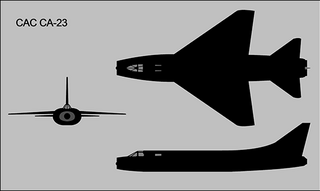
The CAC Boomerang is a fighter aircraft designed and manufactured in Australia by the Commonwealth Aircraft Corporation between 1942 and 1945. Approved for production shortly following the Empire of Japan's entry into the Second World War, the Boomerang was rapidly designed as to meet the urgent demands for fighter aircraft to equip the Royal Australian Air Force (RAAF). It was the first combat aircraft designed and constructed in Australia.

The Mitsubishi F1M is a Japanese reconnaissance floatplane of World War II. It was the last biplane type of the Imperial Japanese Navy, with 944 built between 1936 and 1944. The Navy designation was "Type Zero Observation Seaplane" (零式水上観測機).

The North American Aviation NA-16 is the first trainer aircraft built by North American Aviation, and was the beginning of a line of closely related North American trainer aircraft that would eventually number more than 17,000 examples, notably the T-6 Texan family.

The CAC CA-15, was an Australian propeller-driven fighter aircraft designed by the Commonwealth Aircraft Corporation (CAC) during World War II. Due to protracted development, the project was not completed until after the war, and was cancelled after flight testing, when the advent of jet aircraft was imminent.

The CAC Wirraway is a training and general purpose military aircraft manufactured in Australia by the Commonwealth Aircraft Corporation (CAC) between 1939 and 1946. It was an Australian development of the North American NA-16 training aircraft. The Wirraway has been credited as being the foundation of Australian aircraft manufacturing.

No. 83 Squadron is a Royal Australian Air Force intelligence unit. It was originally formed in 1943 as a 'home defence' fighter squadron and provided air defence to several locations in Queensland, the Northern Territory and New South Wales before being disbanded in 1945. The squadron was re-raised in 2021, and is responsible for a system which integrates intelligence from multiple sources.

No. 84 Squadron was a Royal Australian Air Force (RAAF) fighter squadron of World War II. It was established in February 1943 and was part of the defences of the Torres Strait area from April 1943 until May the next year. After being withdrawn from the Torres Strait the squadron was reduced to a cadre until May 1945, when it began to receive new aircraft. No. 84 Squadron was disbanded in January 1946.
No 85 Squadron was a Royal Australian Air Force (RAAF) fighter squadron which provided air defence to Western Australia during World War II. It was formed in 1943 and disbanded in 1945. The squadron did not see combat during the war, although it attempted to intercept Japanese aircraft on several occasions in 1943, without success.

The Commonwealth Aircraft Corporation (CAC) was an Australian aircraft manufacturer. The CAC was established in 1936, to provide Australia with the capability to produce military aircraft and engines.

The CAC CA-25 Winjeel is an Australian-designed and manufactured three-seat training aircraft. Entering service with the Royal Australian Air Force (RAAF) in 1955 as a basic to advanced trainer, it served in this role until 1975. Later, it was used in the Forward Air Control (FAC) role for target marking until 1994, after which it was retired from RAAF service.

The CAC Wackett Trainer, or simply Wackett, was the first aircraft type designed in-house by the Commonwealth Aircraft Corporation of Australia. The name was derived from its designer Lawrence Wackett.

Sir Lawrence James Wackett is widely regarded as "father of the Australian aircraft industry". He has been described as "one of the towering figures in the history of Australian aviation covering, as he did, virtually all aspects of activities: pilot, designer of airframes and engines, entrepreneur and manager". He was knighted for his services to aviation and was a winner of the Oswald Watt Gold Medal. He was also a keen angler and wrote two books on the subject.

The CA-11 Woomera was a production development of the earlier CA-4 Wackett Bomber prototype, and was an Australian torpedo and dive bomber aircraft that was designed and constructed by the Commonwealth Aircraft Corporation (CAC) during World War II. The order for the Woomera was cancelled before it became operational with the Royal Australian Air Force (RAAF).

The Commonwealth Aircraft CA-28 Ceres was a crop-duster aircraft manufactured in Australia by the Commonwealth Aircraft Corporation (CAC) between 1959 and 1963. The aircraft was a development of the Wirraway trainer of World War II.

The CAC Sabre, sometimes known as the Avon Sabre or CA-27, is an Australian variant of the North American Aviation F-86F Sabre fighter aircraft. The F-86F was redesigned and built by the Commonwealth Aircraft Corporation (CAC). Equipping five Royal Australian Air Force (RAAF) squadrons, the type saw action in the Malayan Emergency in the late 1950s and was employed for air defence in Malaysia and Thailand in the 1960s. Ex-RAAF models also saw service with the Royal Malaysian Air Force and the Indonesian Air Force.
An emergency fighter is an aircraft designed or adapted for use as a fighter at short notice, during an emergency period in war.

Air Vice Marshal Ellis Charles Wackett, CB, CBE was a senior commander in the Royal Australian Air Force (RAAF). Its chief engineer from 1935 to 1959, he served on the RAAF's controlling body, the Air Board, for a record seventeen years, and has been credited with infusing operations with new standards of airworthiness. Commencing his service career as a Royal Australian Navy cadet during World War I, Wackett transferred to the Air Force in 1923 while on an engineering course in Britain. He qualified as a pilot before completing his studies and returning to Australia, where he inaugurated parachute instruction within the RAAF and made the country's first freefall descent from a military aircraft in 1926. The following year, he led a three-month survey flight to Papua New Guinea.

No. 1 Aircraft Depot (No. 1 AD) was a maintenance unit of the Royal Australian Air Force (RAAF). Formed in July 1921 at RAAF Point Cook, Victoria, it relocated to the nearby RAAF Laverton in March 1926. As well as servicing aircraft and other equipment, in its early years the depot supported survey flights in Australia and the Pacific region. It was also responsible for training maintenance staff.

The CAC CA-23 was a planned supersonic, twinjet, two-seat, all-weather fighter aircraft designed by the Commonwealth Aircraft Corporation of Australia.
Roy Francis Goon was an Australian World War II fighter pilot. Goon held Commercial pilot licence No. 511 and was originally an instructor with the Royal Victorian Aero Club (RVAC) at Essendon Airport, then later at Moorabbin, Wangaratta, Benalla, Albury, Corowa, Shepparton, Mildura and Swan Hill. Goon also held Aircraft Engineer's Licence C and D grades.

















